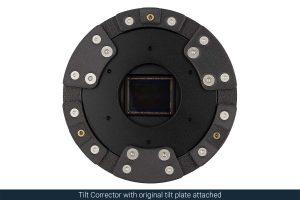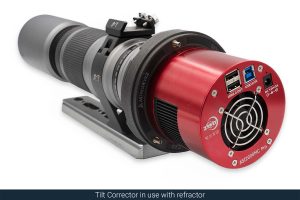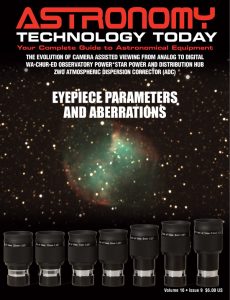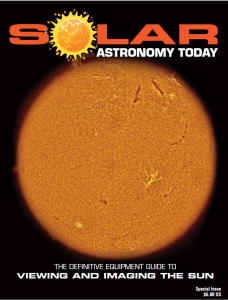The new Tilt Corrector for ZWO ASI Cameras is a device used to make minimal changes in the position of an astrophotographic camera. With the help of this accessory, it is possible to both change the angle of tilt of the sensor and precisely adjust its position along the optical axis (backfocus). With the help of the Tilt Corrector, unwanted sensor tilt can be effectively minimized or completely eliminated.
 As the Astrodevices team notes, “Like any Astrodevice design, the Tilt Corrector for ZWO ASI Cameras is also a solution to a specific problem. In this case, it’s a matter of proper alignment of the sensor in the image train. The thing is that the camera sensor must be set in a plane perfectly perpendicular to the optical axis of the telescope, in addition, at a precise distance from the front of the tube. Any deviation from the ideal state can lead to optical distortion, which usually manifests itself in deformed star shapes in the corners of the frame. The larger the sensor, the greater the scale of the problem. Likewise – the faster the optics, the more severe the problem also becomes. It is for this reason that users of fast telescopes such as the Celestron RASA often face the very difficult tilt problem.”
As the Astrodevices team notes, “Like any Astrodevice design, the Tilt Corrector for ZWO ASI Cameras is also a solution to a specific problem. In this case, it’s a matter of proper alignment of the sensor in the image train. The thing is that the camera sensor must be set in a plane perfectly perpendicular to the optical axis of the telescope, in addition, at a precise distance from the front of the tube. Any deviation from the ideal state can lead to optical distortion, which usually manifests itself in deformed star shapes in the corners of the frame. The larger the sensor, the greater the scale of the problem. Likewise – the faster the optics, the more severe the problem also becomes. It is for this reason that users of fast telescopes such as the Celestron RASA often face the very difficult tilt problem.”
Many modern cooled astrophotographic cameras often have a tilt adjustment mechanism. For example, some ZWO ASI cameras have a distinctive black plate with screws on the front that allows you to enter the tilt of the camera.
As Astrodevices notes, “The original method of adjustment may seem inconvenient to many people. To change the tilt angle, you have to first loosen the mounting screws, then fine-tune the adjustment screws and then tighten the mounting screws again. All of this must be done from the front of the camera, which is very inconvenient and often requires physically removing the camera and then reattaching it after adjustment. This whole process is not only uncomfortable, but also subject to a great deal of uncertainty, as each tightening of the screws, removal and reassembly introduces independent, unwanted misalignments. In the case of some telescopes, e.g., the RASA 8, the camera must be taken off for adjustment because when it is put on the telescope, there is no physical access to its front.”
The Astrodevices decided to create the new Tilt Corrector for ZWO ASI Cameras to have the following functionality:
– Allow adjustment accessible from the rear of the camera.
– Has zero optical length.
– Allows the camera to be used the same as without it.
– Can be used with any telescope and with any accessories (e.g. any filter drawer, any adapters, any filter adapter)
– Very easy adjustment.
 Out of all these ideas came the Tilt Corrector, an accessory for ZWO cameras to easily adjust tilt. The device has the form of a ring. It is attached to the camera using the original mounting screws supplied with the camera itself. It comes with three tilt adjustment screws available from the rear of the camera. There is no need to loosen, tighten or remove the camera to change the settings. Tilt adjustment is available all the time while the camera is mounted on the telescope, so even adjustment with live view is possible.
Out of all these ideas came the Tilt Corrector, an accessory for ZWO cameras to easily adjust tilt. The device has the form of a ring. It is attached to the camera using the original mounting screws supplied with the camera itself. It comes with three tilt adjustment screws available from the rear of the camera. There is no need to loosen, tighten or remove the camera to change the settings. Tilt adjustment is available all the time while the camera is mounted on the telescope, so even adjustment with live view is possible.
Tilt Corrector allows you to use the original tilt plate. First, the Tilt Corrector is mounted to the camera from which the original tilt plate was taken off, and in a second step the tilt plate is screwed to the front of the Tilt Corrector. In this way, the camera again has the original tilt plate on the front, but now the tilt adjustment is done through the Tilt Corrector.
With the ability to use the original tilt plate, the camera can be used as it has always been – attaching the same adapters, connectors and devices to it as without the Tilt Corrector. The presence of the Tilt Corrector in this sense is transparent. The camera with or without the Tilt Corrector can be used the same way, the same accessories can be attached to it.
Thus, the whole set can be used not only with any accessories but also with any telescope.
Tilt Corrector can also be used with Astrodevice 2” filter drawers. Thanks to special clamps, it can also be used with a 900 M87 filter drawer instead of the original tilt plate. It can be also used with Astrodevice RSF R8 single filter adapter.
There is also another very important feature as the Tilt Corrector allows you to transfer the correct tilt settings to the original tilt plate and Astrodevice filter drawers. To do so:
– Put the Tilt Corrector on the camera.
– Set the correct tilt, e.g. in live view.
– Take the camera off the telescope.
– Copy the settings to the original black tilt plate, filter drawer or camera adapter Astrodevice.
– Take off the Tilt Corrector and use the camera with the correct tilt setting.
 You can also use the camera with the Tilt Corrector always on – you have complete freedom here. This is possible even with cameras mounted on the front of the telescope as the Tilt Corrector is as narrow as possible. Even with RASA 8, the Tilt Corrector obscures only 7% more light compared to the default setup with the camera alone. And, if desired, you will be able to take it off after making the right settings.
You can also use the camera with the Tilt Corrector always on – you have complete freedom here. This is possible even with cameras mounted on the front of the telescope as the Tilt Corrector is as narrow as possible. Even with RASA 8, the Tilt Corrector obscures only 7% more light compared to the default setup with the camera alone. And, if desired, you will be able to take it off after making the right settings.
The device is equipped with adjustment screws with a thread pitch of 0.7 mm. The adjustment screws are located 51 mm from the optical axis. This means that when you turn the adjustment screw 5 degrees, you move the corner of the APS-C sensor by about 0.003 mm and therefore you’re able to correct about 0.01 degree of the sensor tilt.
Tilt Corrector is designed to work with these cooled 90mm ZWO ASI cameras: ZWO ASI 2400 MC Pro, ZWO ASI 2600 MM/MC Pro and the ZWO ASI 6200 MM/MC Pro.
You can learn more about the new Tilt Corrector for ZWO ASI Cameras here.

 And to make it easier for you to get the most extensive news, articles and reviews that are only available in the magazine pages of Astronomy Technology Today, we are offering a 1-year magazine subscription for only $6! Or, for an even better deal, we are offering 2 years for only $9. Click here to get these deals which only will be available for a very limited time. You can also check out a free sample issue here.
And to make it easier for you to get the most extensive news, articles and reviews that are only available in the magazine pages of Astronomy Technology Today, we are offering a 1-year magazine subscription for only $6! Or, for an even better deal, we are offering 2 years for only $9. Click here to get these deals which only will be available for a very limited time. You can also check out a free sample issue here.
The sun is more active than it has been in years! If you’d like to learn more the technology behind solar observing, solar imaging and more, you can check out our free publication, “The Definitive Guide to Viewing and Imaging the Sun”. You don’t have to sign up or provide any information, simply click here and enjoy reading!

